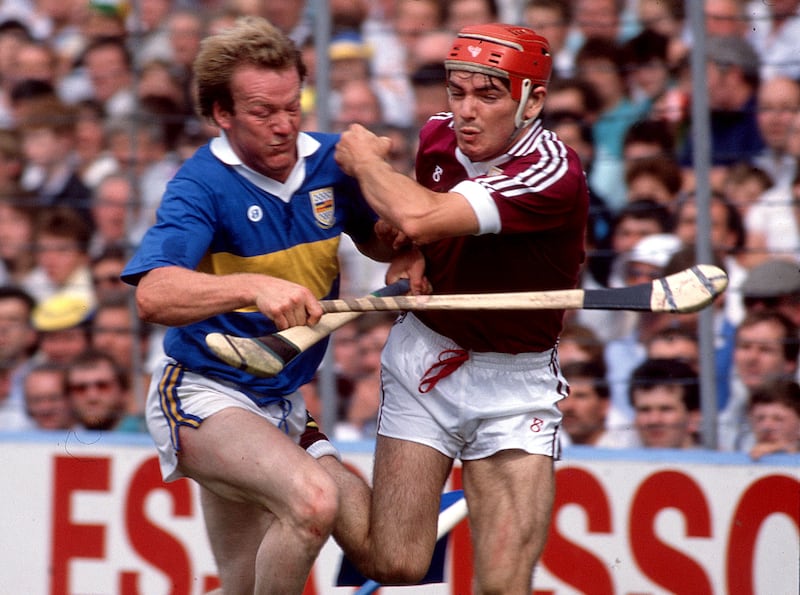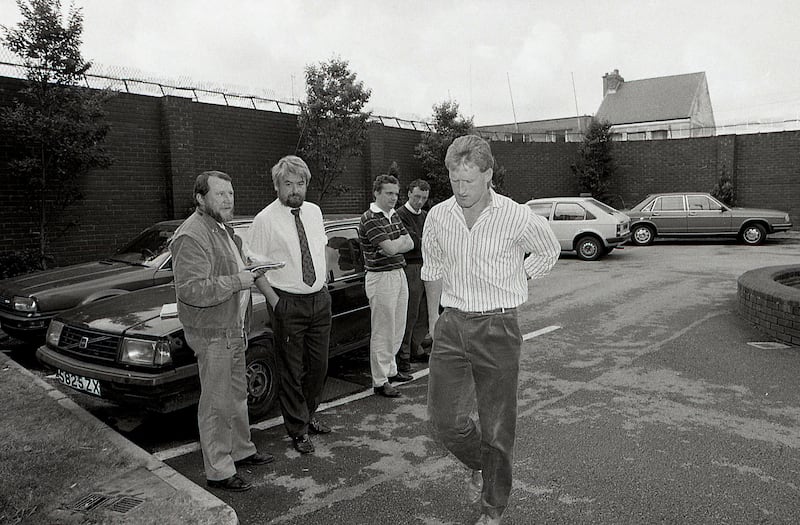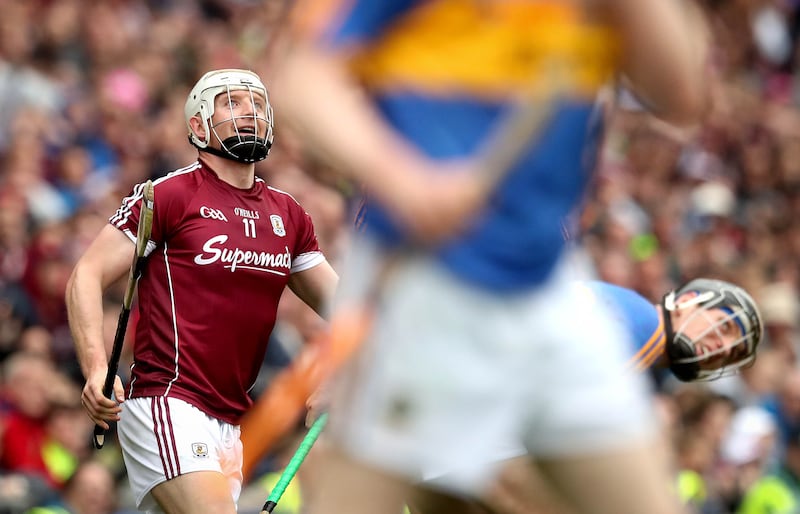By January of 1989, relations had soured. Galway had won the previous two All-Irelands, treading Tipperary underfoot on their way to glory. The details are disputed. Too many eyewitnesses. “Galway,” wrote Babs Keating in his autobiography, “had intimidated our players into submission.” In a situation like that everyone is in a tizzy.
Babs went to India with the jockey Christy Roche that winter, and lying by the pool in Madras, his great friend didn’t put a tooth in it. “What are you going to do to toughen these fellas up?” Roche asked Babs. The question had been rattling around in Babs’ head for months.
On the day he returned from India Babs spoke at a Tipperary Supporters Club dinner that was attended by half a dozen GAA journalists. In the course of his speech Babs scolded the press for not being more vigilant in their reporting of the previous year’s All-Ireland final. “Some of the tactics used against us should not be allowed to go unnoticed,” he said.
Escaping the room like gas, Babs’ words were bound to meet a naked flame. At the Galway GAA convention a couple of days later, the Galway chair Jim Halliday and their Central Council delegate Joe McDonagh both rebuked Babs for his comments. Suddenly, it was a diplomatic incident.
READ MORE
Babs contacted the Tipperary Star to clarify his original remarks, without resigning from them: he was sincere in what he said. Raymond Smith in The Sunday Independent weighed in with two columns. The Galway manager Cyril Farrell had his say in The Sunday Press. Everybody put up their dukes.
When Tipperary and Galway met in the National League final three months later, more than 35,000 people showed up in Croke Park, a massive crowd for a League final. In hurling’s solar system, Galway and Tipp was a new planet. Before 1987, they had met just once in the championship in the previous quarter of a century. Galway hadn’t beaten Tipp since the 1920s. Rivalries depend on mutual fear. Until the late 1980s, no such thing existed between them.

Everyone’s feelings were complicated by where they had come from. Looking out from their stately castles, the Big Three saw Galway as Barbarians at the gate. To be accepted as one of the game’s new superpowers required an unblinking siege.
“It was massive to get the respect [of Tipp, Kilkenny and Cork],” says Noel Lane, the former Galway player and manager. “We probably didn’t deserve it for lots of years. The top three had been the same for nearly 100 years. You had to fight your way into that. We didn’t have the confidence in ourselves to compete with those counties. That all changed. To be able to beat Tipperary, for us, was massive.”
By 1989, though, Tipp hadn’t won an All-Ireland for 18 years, an eternity by their clock. Standing in their way were a crowd that had never much bothered them before their emergence as a serious force a couple of years previously. Galway were classy and bolshie and powerful and unflinching. And hurling back then was different: any ball that fell from the sky could be a missile.
“The hurling in those matches was fairly physical and sometimes bordering on the vicious,” says Lane. “But at the same time, it was in the spirit of the game.”
“There were no holds barred,” says Ken Hogan, the former Tipp goalie and manager. “They were tougher times. It was probably a slower game. Everything was under the dropping ball. Donie O’Connell on Tony Keady, Ollie Kilkenny and Pat Fox, Bobby Ryan and Brendan Lynskey – they were savage, savage battles. It was dog eat dog.
“Obviously the supporters got involved as well. There was probably more rancour between the supporters than there was between the players themselves. That’s usually the way anyway.”

Recurring duels spiced the rolling narrative. Pete Finnerty and John Leahy were the white knight and the black knight, depending on your allegiance. The jousting was relentless: there was hard-hitting and massive hurling and mouthing.
“I said on the radio that someone should have told John I didn’t have a sister,” Finnerty said years later. “John would be saying things and I would be saying things. It went on wholesale. You wanted to get inside his head.”
It reached a climax in the 1989 All-Ireland semi-final, a spiteful, poisonous affair. Leahy flaked across Finnerty’s midriff as he came out with a ball, and somehow wasn’t even booked. “I was very lucky to stay on the field,” Leahy said in his episode of Laochra Gael. “I suppose the two of us bent the rules a small bit in our time. You know, they were hard games.”
The bitter backdrop was Tony Keady’s suspension for playing in New York without Croke Park clearance. In a flight of fancy he lined out for Laois against Tipperary and was rumbled. The story in circulation was that a Tipperary person had been the whistleblower. There were other conspiracy theories about large bets. All of it was Oliver Stone territory.

Babs and the Tipp county board wanted nothing to do with it. Galway threatened not to play the match unless Keady’s suspension was lifted, and when Keady’s appeal reached Croke Park, Tipp voted in Keady’s favour. The suspension stood.
Bad blood spilt on to the field. Two Galway players were sent off. The referee had a nightmare. The All-Ireland champions felt victimised from every angle. Three years of simmering tensions had come to this: the lid flew off the pot.
The amazing part, though, was that it didn’t leave a lingering stain: not in personal relationships, or in the fabric of the rivalry. Over time the tension rinsed through and the relationship morphed into something different. The poison seeped away. In its place is something attractive and admirable.
Since the turn of the century Galway and Tipperary have played in 10 championship matches, and nine of them have been decided by one score: five wins each. Many of them have been spectacular matches. Strip out the 2014 qualifier in Thurles – when Tipp outscored Galway by 2-10 to 0-1 in the last 20 minutes, coming from six points down to win by nine in an astonishing match – and the aggregate difference between the teams in the other nine games is one point. Count it again.
In the middle of all that was a trilogy of All-Ireland semi-finals: 2015, 2016, 2017, each decided by single point. In tone and texture, those matches were nothing like the bloodied battlegrounds of the 1980s. They were hectic and brilliant in different ways.
“A lad said to me,” says Hogan, “‘in the old days, when Galway and Tipperary were playing, you’d need five referees. Now you wouldn’t even need a referee.’”
James Barry played in those games for Tipp in the middle of the last decade. He rooted out the 2015 semi-final on YouTube recently. Only eight years old, it looked like a completely different iteration of the game: Apple 6 or 7 maybe.

“There were big hits in those games too,” says Barry. “Paudie [Maher] and Joe Canning on the side line [in 2016]. Then the following year Gearoid McInerney hit Paudie a shoulder and flattened him. There was no shemozzle, everyone just got up and got on. There was never any bitterness towards Galway. You always knew it was going to be a hard game. Galway always seem to produce physical men. You knew in the full-back line you were going to be tested with aerial ball.
“We had the same mix and match of ages. You know, Seamie Callanan was around the same age as Joe Canning. We both had younger lads. There was nothing between us. 2015 was the Shane Moloney point for Galway, 16 was the Bubbles [O’Dwyer] goal for us, 17 was the Canning point from the side line. We were both waiting in the wings for Kilkenny’s dominance to finish.”
In those years they both landed on an All-Ireland. Beating each other was a gateway. “We won by a point in 2015,” says Colm Callanan, the former Galway goalie. “I think the Galway team of 2017 would have won that game by seven or eight points. Equally, the Tipperary 2017 team would have beaten that Galway team by seven or eight points. Each year, both teams moved on a level.”
Off the field there were all kinds of unusual exchanges. Micheal Donoghue spent a year in Tipp with Eamon O’Shea, like an internship, before he took the Galway job; Tony Og Regan, the former Galway player, was Tipp’s performance coach in 2016; later that year Galway poached Lukasz Kirszenstein from Tipp to lead their strength and conditioning; this year, O’Shea headed up Galway’s development squad.
None of that ever went on between Cork, Tipp and Kilkenny. Those borders were closed to each other.
The Galway and Tipp players from the 1980s finished on good terms. Some of them became friends. During his playing days Hogan lived for a few years in Phibsboro, on Dublin’s north side, and he used to go drinking with Keady and Lynskey: The Hut or the Garda Club were their regular haunts.
[ Tony Keady – ‘The bigger the occasion, the better he was’Opens in new window ]
Keady used to tell a story about a fundraising event for the former Galway player Eanna Ryan, who had suffered a terrible injury. On a stormy night the Tipp players travelled en bloc by bus. “They had a chainsaw in the back in case there were any trees down along the road,” said Keady. “Bobby Ryan showed it to me. Nothing was going to stop them getting there.”
When Keady died in 2017, the Tipp players hit the road again. “Even when we had team reunions, we didn’t have as good a turnout as we had for Tony’s funeral,” says Hogan. “That bore testament to the respect we had for each other in later years.”
No hard feelings.
[ Nicky English: It looks like open season for this year’s hurling All-IrelandOpens in new window ]



















